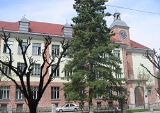
Mladika
Encyclopedia
The Mladika building is the headquarters of the Ministry of Foreign Affairs
of the Republic of Slovenia
, located in the country's capital Ljubljana
.
The building was built after the Ljubljana earthquake of 1895, as part of a wider plan of urban renovation carried out by the mayor Ivan Hribar
. It was designed by the Slovene architect Max Fabiani
in the Art Nouveau
style, with a red bricked façade
adorned with stucco
floral motifs and owls
, symbolizing wisdom
. The main entrance is also surmounted by a clock turret .
The building's name comes from the private education institute Mladika ("Offspring"), which in 1896 established a secondary school for girls on the same location. The Mladika Institute was sponsored by the wealthy Slovene patriot from Ljubljana, Josip Gorup, who commissioned the present building to architect Max Fabiani
in 1907. In 1912, a second building (known as Licej) was built by architect Ciril Metod Koch
to host the boarding house. Both buildings, located next to the Tivoli Park, are now used as the seat of the Slovenian Foreign Ministry.
The Mladika building is located opposite to the Slovenian Government Palace.
Government of Slovenia
The Government of the Republic of Slovenia is the cabinet that excersises executive authority in Slovenia pursuant to the Constitution and the laws of Slovenia. It is also the highest administrative authority in Slovenia. It comprises the Prime Minister and 15 ministers, three of them without...
of the Republic of Slovenia
Slovenia
Slovenia , officially the Republic of Slovenia , is a country in Central and Southeastern Europe touching the Alps and bordering the Mediterranean. Slovenia borders Italy to the west, Croatia to the south and east, Hungary to the northeast, and Austria to the north, and also has a small portion of...
, located in the country's capital Ljubljana
Ljubljana
Ljubljana is the capital of Slovenia and its largest city. It is the centre of the City Municipality of Ljubljana. It is located in the centre of the country in the Ljubljana Basin, and is a mid-sized city of some 270,000 inhabitants...
.
The building was built after the Ljubljana earthquake of 1895, as part of a wider plan of urban renovation carried out by the mayor Ivan Hribar
Ivan Hribar
Ivan Hribar was a Slovene and Yugoslav banker, politician, diplomat and journalist. At the turn of the century, he was one of the leaders of the National Progressive Party, and one of the most important figures of Slovene liberal nationalism...
. It was designed by the Slovene architect Max Fabiani
Max Fabiani
Max Fabiani, was a Slovene-Italian architect from the Gorizia region. Together with Ciril Metod Koch, he introduced the Vienna Secession style of architecture in the Slovene Lands.-Life:...
in the Art Nouveau
Art Nouveau
Art Nouveau is an international philosophy and style of art, architecture and applied art—especially the decorative arts—that were most popular during 1890–1910. The name "Art Nouveau" is French for "new art"...
style, with a red bricked façade
Facade
A facade or façade is generally one exterior side of a building, usually, but not always, the front. The word comes from the French language, literally meaning "frontage" or "face"....
adorned with stucco
Stucco
Stucco or render is a material made of an aggregate, a binder, and water. Stucco is applied wet and hardens to a very dense solid. It is used as decorative coating for walls and ceilings and as a sculptural and artistic material in architecture...
floral motifs and owls
OWLS
OWLS is a mnemonic used by general aviation airplane pilots to assess an unprepared surface for a precautionary landing.Like all mnemonics this check has become part of aviation culture and folklore.OWLS:* Obstacles* Wind direction...
, symbolizing wisdom
Wisdom
Wisdom is a deep understanding and realization of people, things, events or situations, resulting in the ability to apply perceptions, judgements and actions in keeping with this understanding. It often requires control of one's emotional reactions so that universal principles, reason and...
. The main entrance is also surmounted by a clock turret .
The building's name comes from the private education institute Mladika ("Offspring"), which in 1896 established a secondary school for girls on the same location. The Mladika Institute was sponsored by the wealthy Slovene patriot from Ljubljana, Josip Gorup, who commissioned the present building to architect Max Fabiani
Max Fabiani
Max Fabiani, was a Slovene-Italian architect from the Gorizia region. Together with Ciril Metod Koch, he introduced the Vienna Secession style of architecture in the Slovene Lands.-Life:...
in 1907. In 1912, a second building (known as Licej) was built by architect Ciril Metod Koch
Ciril Metod Koch
Ciril Metod Koch was a Slovene architect. Together with Max Fabiani, he introduced the Vienna Secession style in the Slovene Lands....
to host the boarding house. Both buildings, located next to the Tivoli Park, are now used as the seat of the Slovenian Foreign Ministry.
The Mladika building is located opposite to the Slovenian Government Palace.

